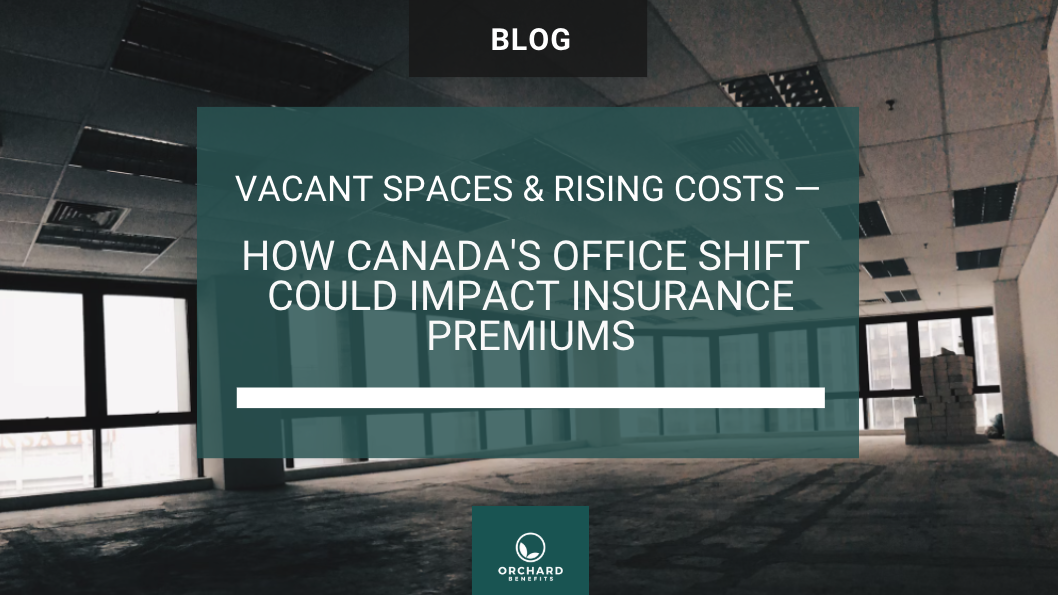The other day, I was downtown for a meeting and glanced out the window—only to realize how many floors across the street were dark and empty. Entire sections of once-coveted office towers now look like ghost floors. And once you see it, you can’t unsee it.

In the wake of the COVID-19 pandemic, hybrid work and shifting office priorities have left a lasting mark on Toronto’s commercial real estate market. Downtown vacancy rates reached 17.2% by Q3 2024, a number that signals more than just a real estate problem, it’s a sign of broader economic pressure that’s starting to affect insurers and, by extension, the group benefits landscape many employers rely on.
Commercial Real Estate Is Cracking. And That Has Insurance Implications
Toronto’s commercial real estate market is still recalibrating post-COVID. With vacancy rates above 17%, the shift to hybrid work isn’t just leaving offices empty—it’s putting pressure on landlords and reshaping how insurers assess risk.
And companies aren’t just looking for less square footage, they’re looking for better square footage. Higher-quality buildings with proper HVAC, natural light, and collaborative layouts are winning leases. Meanwhile, aging towers in the Financial District are being left behind. They’re harder to lease, more expensive to maintain, and less attractive to insurers. And when insurers see more risk and lower returns, they start adjusting underwriting and pricing strategies, which trickles down to employers holding group policies with them.
Canada’s Life Insurers Are Heavily Exposed to Office Real Estate Losses
Canada’s four largest life insurers, Manulife, Sun Life, Great-West Lifeco, and iA Financial, hold significant investments in commercial office properties. Toronto-based Manulife, which holds 74 million square feet of real estate across 34 cities worldwide, reported a 40% decline in the value of its U.S. office investments and a 12% year-over-year drop in its global office portfolio valuation. These devaluations create risk for insurers’ real estate portfolios, potentially impacting long-term financial performance.
Why It Matters for Employers and Plan Sponsors
Most plan sponsors overlook how their group benefits provider manages its investment portfolio, even though it deserves their attention. Canada’s largest life insurers aren’t just underwriting health and dental plans; they’re also heavily invested in commercial real estate.
When those buildings lose value, it creates financial pressure. To maintain margins, insurers may increase group insurance premiums, tighten plan offerings, or change how they assess risk across industries.
- 40% of the Big 4 life insurers’ commercial real estate (CRE) portfolios are in office space.
- About 20% of their CRE mortgage holdings are tied to office buildings (1.8% of total assets).
- Life insurers began reducing office real estate exposure even before the pandemic.
Even if your team’s usage or claims haven’t changed, broader market forces could still drive up your costs.
Why Toronto’s Skyrocketing Construction Costs Are Everyone’s Problem
The pressure on commercial insurance premiums isn’t just about empty buildings or market demand; it’s also about cost volatility. The Insurance Bureau of Canada reports that the cost of building materials has increased by over 67% in the past five years, far outpacing general inflation.
In cities like Toronto, where severe weather events caused more than $1 billion in flood damage in 2024 alone, insurers are paying out more than ever—while also facing delays and shortages in materials and skilled labour. This strain on the property insurance market has ripple effects: the more insurers spend to resolve claims, the more likely they are to raise premiums across the board. For employers leasing space or relying on group insurance programs backed by these same carriers, that could mean higher costs in the near future, even if your company’s own claims record is spotless.
From Office Towers to Premium Hikes
Vacant properties don’t just strain finances; they attract risk. Empty floors mean less oversight, which increases the chances of issues like water damage, break-ins, and fire hazards going unnoticed. And for insurers, more risk means more scrutiny.
On top of that, inflation is pushing claim costs through the roof. The cost of materials like cement, wood, and metal has risen as much as 40% over the past five years, and insurers are still digging out from a record-breaking $8.5 billion in weather-related losses in 2024. Combine rising risk with rising costs, and you have a perfect storm for higher premiums and stricter underwriting.
For landlords, this means it’s getting more complex (and more expensive) to fully insure underused buildings. But for employers—especially those with group benefits tied to large carriers or property-based risk pools—it’s another signal that insurance costs may rise, even if your own usage or claims history hasn’t changed.
What Employers Should Be Watching For Next
The commercial real estate downturn isn’t just a landlord problem—it’s shaking up the investment portfolios of Canada’s largest life insurers, many of whom also provide group benefits. With office building valuations down as much as 40%, these institutions are under pressure to protect returns.
That pressure can lead to tighter underwriting, changes to plan structures, or premium increases that hit employers down the line.


